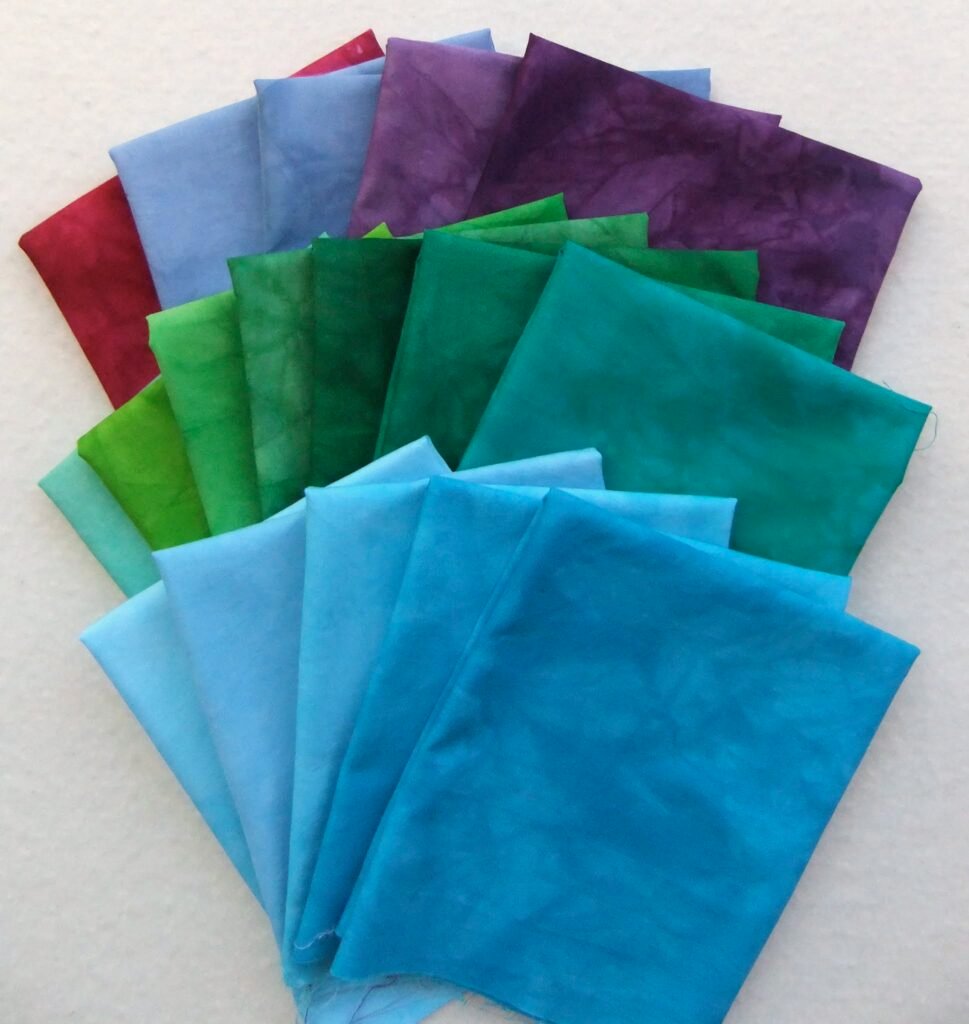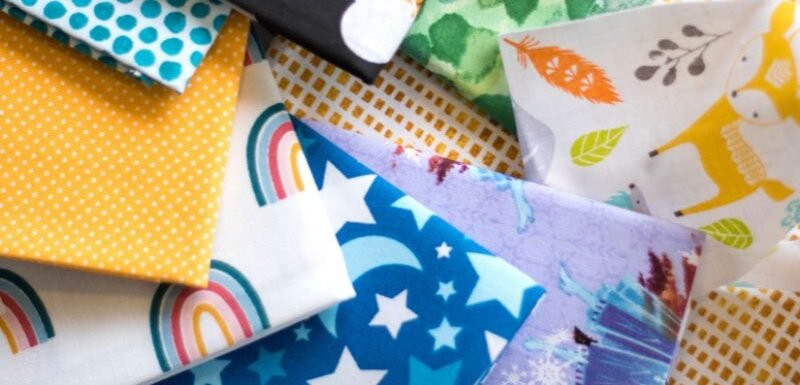Learn how to prepare and care for quilting fabric. Discover the best practices for pre-washing, ironing, and storing your quilting fabric to maintain quality and vibrancy for years to come.
Proper fabric preparation and care are crucial in the art of quilting and the broader topic of textile art. From pre-washing and pre-shrinking (where necessary) to ironing and storage, each step ensures the longevity and beauty of your quilting fabrics.
In this article, I offer some tips for preparing fabric for quilting and how best to store it when not in use.
Disclosure: Some of the links below are affiliate links, which means I may receive a small commission (at no further expense to you) if you click through and make a purchase. As an Amazon Associate I earn from qualifying purchases from Amazon websites.
Pre-washing Quilting Fabric: Necessary or Not?
The first step is to decide whether to pre-wash your fabric or not.
Unless you’ve chosen bright or bold-coloured fabric and are worried the colours may bleed into each other when your quilt is finished, I don’t recommend pre-washing quilting fabric. The washing process may leave you with fabric that has lost its vibrant hue.
Cuts and fabrics that should not be pre-washed:
- Pre-cuts, like charm packs or jelly rolls, should also not be pre-washed due to their small size.
- Fabrics with special finishes or embellishments, like metallic accents or embroidery, may also forgo pre-washing to preserve these details.
- Additionally, you can skip pre-washing the fabric if you desire a vintage, crinkly look to your finished quilt.
How to Pre-wash Quilting Fabric
There are certainly times when you may want to pre-wash your quilting fabric.
One instance is when you want to remove any excessive sizing or coating or to pre-shink cotton fabric (see next section).
Sizing is a protective coating applied to yarns before being woven. It’s designed to increase the fabric’s ‘hand’ and quality.
Pre-washing helps remove excess dye, preservatives, and dirt or chemicals on the fabric’s surface.
How to Pre-wash Quilting Fabric
- Before washing, sort and separate fabrics by colour to prevent bleeding, especially for bright colours. Avoid washing a mixed load of colours — wash dark colours and brights separately. Pastel colours may be washed together if the colours are similar.
- Use a mild, detergent (or no detergent) and cold water to preserve the fabric’s colour and integrity.
- Wash your fabric using the same method you intend using in the future.
- So if you plan to always hand wash your project pre-wash the fabric by hand. Leave the fabric to soak for 30-60 minutes in cold water before rinsing.
- If machine washing is on your agenda, set your machine to the gentlest cycle.
Drying fabric after pre-washing
- Do not wring or twist your fabric as this may damage the thread alignment. Instead, gently squeeze out excess water and hang to dry.
- Line dry your fabric in the shade until still just damp — using a tumble dryer may cause the fabric to shrink, and exposure to bright sunlight may result in faded colours.
- Press your damp fabric with a warm-hot iron (depending on the type of fabric) to remove the final dampness.
What About Synthetic Fabric?
Most synthetic fabric, e.g. polyester and nylon, will not shrink in the wash. However, if you want to remove any remaining chemicals or excess dye (to prevent bleeding), then pre-washing may be a good idea.
You can skip pre-washing synthetics if the fabric will be incorporated into a wall handing, art quilt, or utilitarian items such as bags that will never be washed.
How Should Hand-dyed Fabric Be Washed?

If you’re like me and use a lot of hand-dyed fabric in my art quilts, it’s important to understand how it should be washed.
I don’t recommend using most hand-dyed fabric for utilitarian bed or lap quilts that will be subjected to repeated washing as the colours may continue to bleed for some time after the dyeing process is finished.
The actual dyeing process determines how well the colour impregnates into the fabric, so be aware that some dyes are much more prone to bleeding than others.
- For the best results when dying fabric, I recommend using Procion MX fibre-reactive dyes.
- After the dye has ‘fixed’ with the fabric, it will need to be washed in hot water.
- Adding Synthropol (a concentrated fabric detergent) or Bubble Jet Set 2000 to the wash helps preserve the colours.
- Keep in mind that although the rinse water may appear clear, more dye is likely to leach from the fabric during subsequent washes.
How to Prevent Fraying When Pre-washing
Whether you’re pre-washing by hand or machine, you should take steps to prevent the fabric from fraying — especially if the fabric has a loose weave or low thread count.
Loosely woven fabric is very prone to fraying, so let’s look at how this can be prevented or minimised.
How to prevent fraying:
- Baste the edges of loosely woven fabric before washing. Fabric such as batik, with its high thread count, is less prone to fraying. However, care and prevention should still be taken.
- If washing by machine, place the fabric inside a mesh laundry bag to minimise the amount of movement in the machine.
Pre-Shrinking Quilting Fabrics
If you survey a cross-section of quilters, you’ll find supporters and opponents of pre-shrinking quilting fabric. And there are certainly times when you may want to minimise shrinkage before making up your quilt.
Quilts made from 100% cotton are prone to some natural shrinkage when first washed. However, if that first wash takes place after you’ve finished your quilt, it can actually enhance your quilt’s appearance.
When should you consider pre-shrinking your fabric?
Natural fibres, such as cotton, are prone to shrinkage, and there may be times when you want to ensure that your quilt remains stable after completion. In this instance, pre-shrinking the fabric can be a good idea.
However, I don’t recommend pre-washing or pre-shrinking art quilts and wall hangings that will never be washed. Why risk having your fabric unnecessarily lose colour intensity?
If you decide to pre-shrink your fabric, wash and dry it the same way you plan to launder your finished quilt. This step ensures your fabric won’t shrink after your quilt is constructed, maintaining the design’s alignment and precision.
Ironing Fabrics for Quilting
Ironing your fabric before cutting is crucial for accurate cutting and piecing.
- Ensure your iron’s heat setting is suitable for the fabric type. Typically, cotton settings work for most quilting fabrics. However, art quilts often include synthetic fabrics which are easily scorched or melted under a very hot iron.
- Avoid using steam, as it can distort the fabric.
- Always iron on a clean, lint-free surface, moving the iron up and down in a pressing motion rather than sliding it around (which may stretch the fibres out of alignment).
- Make sure the iron’s metal soleplate is clean before switching it on. Any dirt on the soleplate or lurking in the steam vents can leave dirty dark marks on your new fabric.
Storing Quilting Fabrics: Preserve their Beauty
Proper quilting fabric storage can significantly prolong its lifespan.
- Store your fabric in a cool, dry place, away from direct sunlight, to prevent fading.
- Avoid plastic bags, which can trap moisture, leading to mould or mildew. Instead, opt for fabric-friendly containers, acid-free boxes, or cloth bags.
- Art quilts and wall-hangings which, by their very nature, are designed to be permanently on display, should be hung on a wall out of direct sunlight.
- Consider framing art quilts and wall hangings, placing the quilt underneath UV glass. While not everyone enjoys the appearance of wall hangings under glass or perspex, there’s no doubt that it helps preserve colours and keeps the textile free of dust.
Preparing and Caring for Quilting Fabric: It’s Worth the Effort
Proper fabric preparation and care is a worthwhile investment in your quilting journey.
Washing, pre-shrinking, ironing, and correctly storing your fabric can dramatically affect the quality, appearance, and longevity of your finished quilt.
But remember, each piece of cloth is unique, and understanding its individual characteristics — and how you intend to it — will help you determine the best care and preparation methods.
